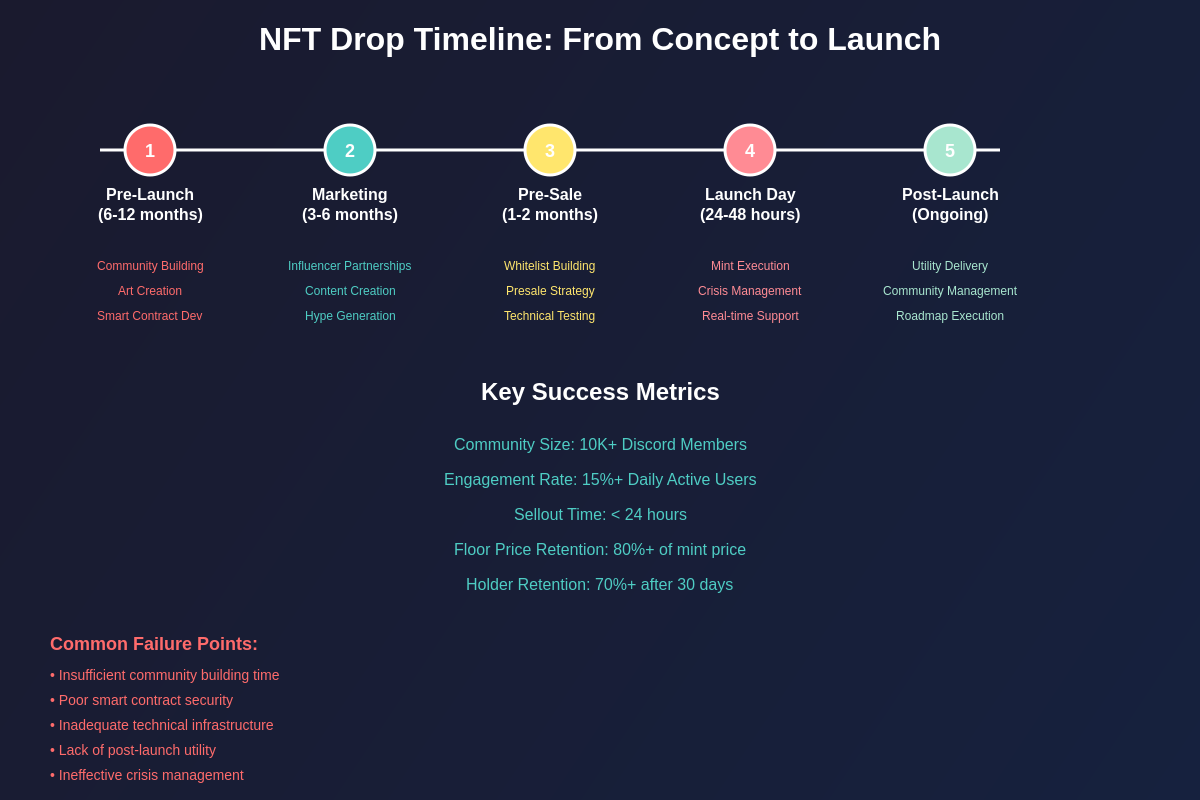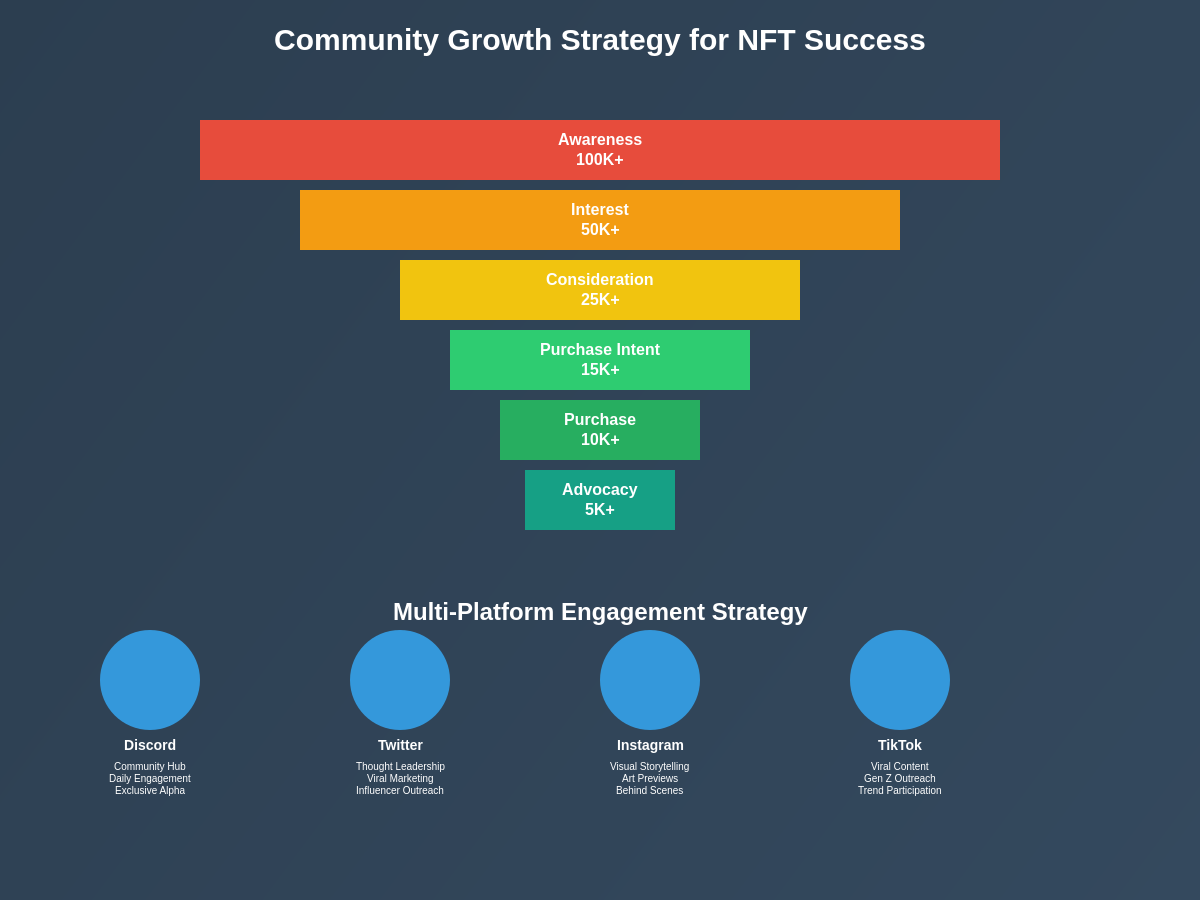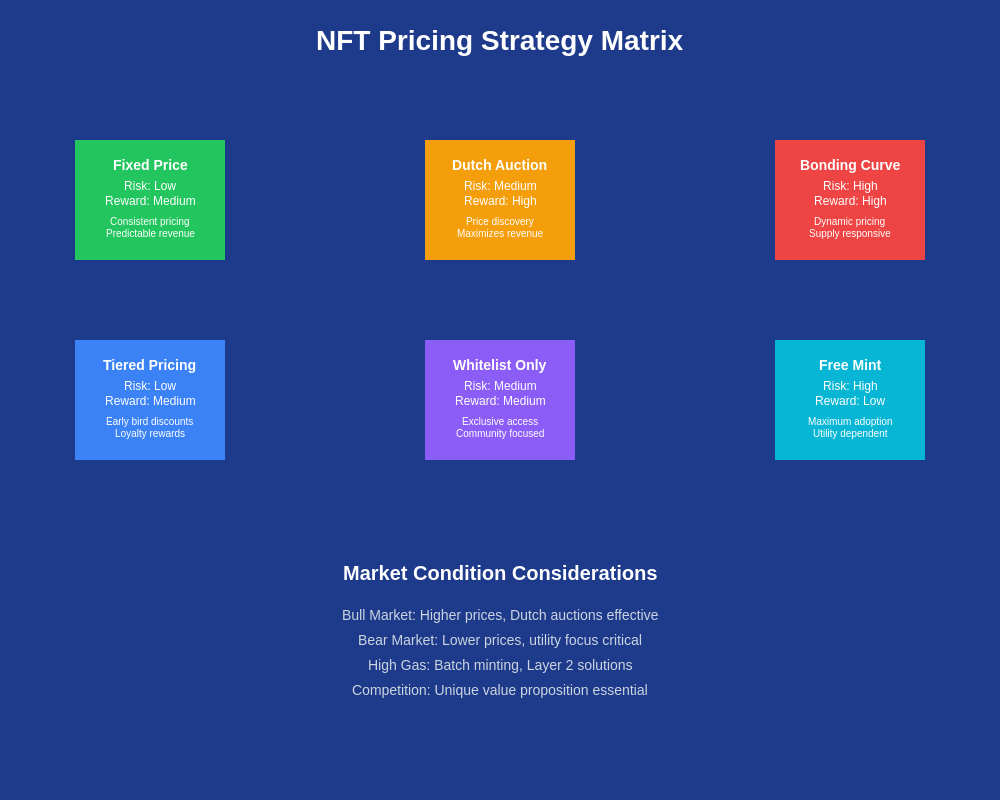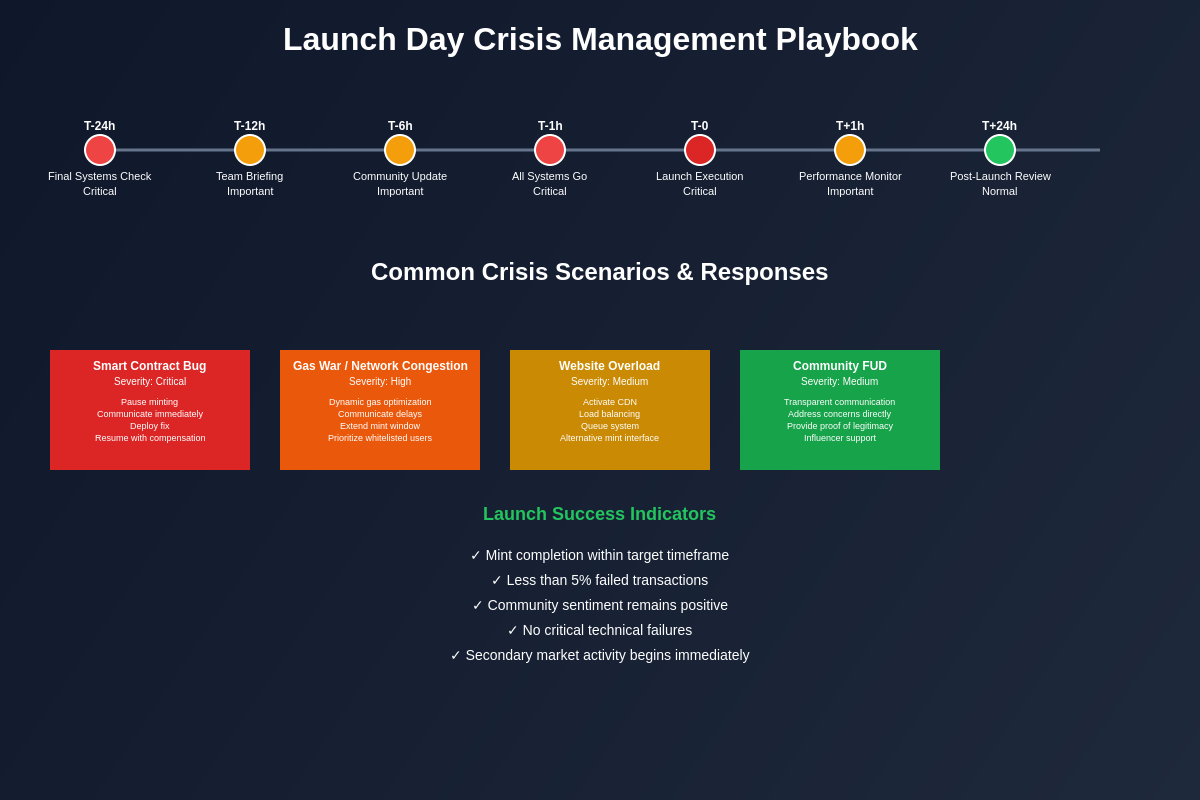Trading strategies and market analysis tools are essential for NFT success
Pre-Launch Foundation and Community Building
The success of any NFT drop begins months before the actual launch, with strategic community building forming the cornerstone of sustainable long-term success in the competitive digital collectibles marketplace. Successful NFT projects understand that creating value extends far beyond the artwork itself, encompassing community engagement, utility development, and strategic positioning within the broader NFT ecosystem that continues to evolve rapidly as market dynamics shift and collector preferences mature.

Community building represents the most critical factor in determining NFT drop success, with projects that invest significant time and resources in cultivating engaged, passionate communities consistently outperforming those that focus solely on artwork quality or technical innovation. The most successful NFT launches typically begin community building six to twelve months before their planned drop date, allowing sufficient time to develop authentic relationships with potential collectors while establishing the trust and credibility necessary for sustained success in an increasingly crowded marketplace.
Discord servers have emerged as the primary platform for NFT community development, providing creators with powerful tools for engagement, education, and relationship building that extend far beyond simple promotional activities. Successful Discord communities feature carefully structured channels for different types of engagement, including general discussion, artwork reveals, educational content, and exclusive alpha information that provides genuine value to community members while building anticipation for upcoming drops.
The importance of authentic engagement cannot be overstated, with collectors becoming increasingly sophisticated in their ability to distinguish between genuine community building efforts and superficial promotional campaigns designed primarily to drive short-term sales. Projects that succeed in building lasting communities focus on providing consistent value through educational content, exclusive access to development updates, and opportunities for community members to contribute meaningfully to project development and decision-making processes.
Social media presence across multiple platforms including Twitter, Instagram, and emerging platforms like TikTok and Clubhouse provides additional touchpoints for community engagement while enabling projects to reach broader audiences beyond traditional NFT collector circles. The most effective social media strategies combine regular content updates with authentic engagement, responding personally to comments and questions while sharing behind-the-scenes content that humanizes the creative process and builds emotional connections with potential collectors.
Influencer partnerships and collaborations with established NFT collectors, artists, and industry personalities can significantly amplify community building efforts, though these relationships must be carefully cultivated to ensure authenticity and alignment with project values. Market analysis tools help identify optimal timing for influencer collaboration announcements and track their impact on community growth and engagement metrics.

Strategic Marketing and Hype Generation
Marketing strategy for NFT drops requires a delicate balance between generating sufficient excitement to drive demand while avoiding oversaturation that can lead to community fatigue or skepticism about project sustainability. The most successful marketing campaigns employ multi-phase approaches that gradually build anticipation through carefully timed revelations, exclusive previews, and strategic partnerships that expand reach while maintaining authenticity and community focus.
Content marketing plays a crucial role in NFT drop success, with projects that consistently produce high-quality educational and entertaining content significantly outperforming those that rely solely on traditional advertising approaches. Successful content strategies include regular blog posts exploring the project’s artistic vision and technical innovation, video content showcasing the creative process and team expertise, and interactive content that encourages community participation and user-generated content creation.
The timing of marketing activities requires careful coordination with broader market conditions, seasonal trends, and competing project launches to maximize visibility and minimize potential conflicts that could dilute marketing effectiveness. Projects that succeed in timing their marketing campaigns effectively often utilize sophisticated market analysis tools to identify optimal windows for major announcements and promotional activities.
Storytelling represents one of the most powerful marketing tools available to NFT creators, with projects that develop compelling narratives around their artwork, creative process, and long-term vision consistently achieving higher engagement rates and stronger community loyalty. Effective NFT storytelling goes beyond simple descriptions of artwork features to explore deeper themes, cultural significance, and the emotional journey that inspired the creative process.
Cross-promotion partnerships with complementary NFT projects, artists, and brands can significantly expand marketing reach while providing mutual benefits that strengthen relationships within the broader NFT community. These partnerships often involve collaborative artwork creation, joint marketing campaigns, and shared community events that provide additional value to collectors while expanding each project’s potential audience.
Press coverage and media outreach require strategic planning and professional execution, with successful projects often working with specialized NFT marketing agencies or public relations professionals who understand the unique dynamics of digital collectibles media coverage. Effective media strategies include preparing comprehensive press kits, developing relationships with key NFT and cryptocurrency journalists, and timing announcements to maximize coverage potential.
Technical Infrastructure and Smart Contract Optimization
The technical foundation underlying NFT drops directly impacts both launch success and long-term project sustainability, with poorly planned technical infrastructure frequently resulting in failed launches, frustrated collectors, and damaged project reputation that can be difficult to recover from in the competitive NFT marketplace. Successful projects invest heavily in robust technical infrastructure that can handle high transaction volumes while providing seamless user experiences during the critical launch period.
Smart contract development and optimization require specialized expertise in blockchain technology, gas optimization techniques, and security best practices that protect both creators and collectors from potential vulnerabilities or exploits. The most successful NFT smart contracts incorporate advanced features including randomized metadata assignment, batch minting capabilities, and flexible pricing mechanisms that enable dynamic pricing strategies based on demand and market conditions.
Gas optimization represents a critical consideration for NFT drops on Ethereum and other blockchain networks where transaction costs can significantly impact collector participation and project profitability. Advanced gas optimization techniques include batch processing for multiple transactions, efficient data storage methods, and smart contract architecture that minimizes computational complexity while maintaining functionality and security.
Scalability planning becomes increasingly important as NFT projects grow in size and complexity, with successful drops often requiring infrastructure capable of handling thousands of simultaneous transactions without performance degradation or system failure. This infrastructure typically includes redundant systems, load balancing, and partnership with reliable blockchain infrastructure providers who specialize in high-volume NFT operations.
Security auditing by reputable blockchain security firms provides essential protection against smart contract vulnerabilities that could compromise project integrity or collector funds. Professional security audits examine smart contract code for potential exploits, test various attack scenarios, and provide detailed recommendations for improving contract security and resilience.
Metadata management and IPFS integration require careful planning to ensure long-term accessibility and immutability of NFT assets, with successful projects implementing redundant storage solutions and clear policies for metadata maintenance and updates. Technical analysis tools help optimize smart contract deployment timing to minimize gas costs and maximize network efficiency.
Pricing Strategy and Economic Models
Pricing strategy represents one of the most critical decisions facing NFT creators, with pricing levels directly impacting both initial drop success and secondary market performance that determines long-term project value and collector satisfaction. Successful pricing strategies consider multiple factors including artwork quality, community size, market conditions, utility offerings, and competitive positioning within the broader NFT landscape.
Market research and competitive analysis provide essential data for informed pricing decisions, with successful projects conducting thorough analysis of comparable NFT drops to understand pricing trends, demand patterns, and collector preferences that influence purchasing decisions. This research often reveals important insights about optimal pricing ranges for different project types, artwork styles, and community sizes.
Dynamic pricing mechanisms enable projects to adjust pricing based on real-time demand while maximizing revenue potential and ensuring broad collector participation. These mechanisms might include Dutch auction formats that start with higher prices and gradually decrease, tiered pricing based on mint timing, or bonding curve models that increase prices as supply decreases.
Utility integration significantly impacts pricing strategy, with NFT projects that offer meaningful utility beyond collectible value often commanding premium pricing while providing ongoing value to holders. Utility offerings might include access to exclusive events, governance rights, revenue sharing, or integration with gaming and metaverse platforms that provide ongoing engagement opportunities.
Rarity distribution and trait weighting directly influence secondary market value and collector satisfaction, requiring careful balance between common and rare attributes that create engaging collecting experiences without frustrating participants. Successful rarity systems often incorporate multiple trait categories with varying rarity levels that create diverse collecting strategies and secondary market dynamics.
Economic sustainability requires pricing strategies that support both immediate drop success and long-term project development, with successful creators often allocating portions of mint proceeds toward ongoing community development, utility expansion, and marketing activities that maintain project momentum beyond the initial launch phase.

Launch Day Execution and Crisis Management
Launch day execution requires meticulous planning and real-time adaptability to address the numerous challenges that can arise during high-demand NFT drops, from technical difficulties and gas wars to unexpected market conditions and community management issues that require immediate attention and professional resolution. Successful launch day management often determines the difference between project success and failure in the unforgiving NFT marketplace.
Technical monitoring and support systems must be fully operational before launch to identify and address potential issues before they impact collector experience or project reputation. These systems typically include real-time monitoring of smart contract performance, website functionality, Discord server stability, and blockchain network conditions that could affect transaction processing and user experience.
Communication strategy during launch becomes critical for maintaining community confidence and managing expectations during periods of high stress and uncertainty. Successful projects maintain transparent, frequent communication through multiple channels including Discord announcements, Twitter updates, and website notifications that keep collectors informed about launch progress, any technical issues, and expected resolution timelines.
Crisis management protocols should be established well before launch day to ensure rapid response to unexpected challenges including smart contract bugs, overwhelming demand, network congestion, or external factors that could impact launch success. These protocols typically include predefined communication templates, escalation procedures, and decision-making authority that enables quick response without compromising project integrity.
Customer support infrastructure must be scaled appropriately for expected launch volume, with sufficient staffing and resources to address collector questions, technical issues, and transaction problems that inevitably arise during high-demand drops. Professional customer support often makes the difference between temporary frustration and permanent community damage that can impact long-term project success.
Contingency planning for various failure scenarios enables projects to respond professionally to technical problems, overwhelming demand, or other issues that could compromise launch success. These contingency plans might include backup minting mechanisms, alternative distribution methods, or postponement strategies that preserve community trust while ensuring fair access for all collectors.
Real-time analytics and performance monitoring provide essential data for making informed decisions during launch day, including adjustments to pricing, supply, or technical parameters that optimize performance and collector satisfaction. Live market data helps inform real-time strategy adjustments during critical launch periods.

Post-Launch Community Management and Utility Delivery
Post-launch community management represents a critical phase that often determines long-term project success, with many NFT drops experiencing significant community decline after initial excitement fades without ongoing engagement, utility delivery, and value creation that maintains collector interest and supports secondary market performance. Successful post-launch strategies focus on sustained community engagement, roadmap execution, and continuous value creation that justifies initial collector investment.
Roadmap execution and milestone delivery require careful project management and clear communication about progress, challenges, and timeline adjustments that maintain community confidence while managing expectations for complex development projects. Successful projects typically provide regular progress updates, milestone celebrations, and transparent communication about any delays or changes to planned deliverables.
Secondary market support through various mechanisms including creator royalties, holder rewards, and utility enhancements helps maintain floor price stability while providing ongoing value to collectors who support the project through secondary purchases. These support mechanisms often include periodic airdrops, exclusive access to future drops, or utility upgrades that increase holding value.
Community governance and holder participation in project decisions creates stronger emotional investment while ensuring that project development aligns with collector preferences and market demand. Governance systems might include formal voting mechanisms, community feedback sessions, or advisory roles for long-term holders who demonstrate ongoing engagement and support.
Utility expansion and feature development require ongoing investment and development resources that successful projects allocate from initial mint proceeds and ongoing revenue streams. Utility development might include gaming integration, metaverse functionality, physical merchandise, or exclusive experiences that provide tangible value beyond speculation.
Partnership development and ecosystem integration create additional value streams while expanding project reach and utility for holders. Strategic partnerships might include collaborations with other NFT projects, integration with DeFi protocols, or partnerships with brands and organizations that provide real-world utility and recognition.
Analytics and Performance Optimization
Data-driven decision making becomes essential for optimizing NFT drop performance and identifying areas for improvement in future launches, with successful projects implementing comprehensive analytics systems that track community engagement, marketing effectiveness, technical performance, and financial metrics that inform strategic decisions and resource allocation priorities.
Community analytics including engagement rates, growth metrics, and sentiment analysis provide valuable insights into community health and satisfaction that enable proactive management and strategic adjustments. These metrics often reveal important patterns about optimal posting times, content preferences, and engagement strategies that maximize community participation and satisfaction.
Marketing performance measurement across various channels and tactics enables efficient resource allocation while identifying the most effective strategies for community growth and engagement. Performance metrics might include social media engagement rates, influencer collaboration effectiveness, content performance, and conversion rates from various marketing activities.
Technical performance monitoring including smart contract efficiency, website performance, and user experience metrics helps identify optimization opportunities while ensuring that technical infrastructure meets collector expectations and industry standards. Technical analytics often reveal important insights about optimal launch timing, capacity planning, and infrastructure investment priorities.
Financial performance analysis including mint performance, secondary market activity, and revenue allocation provides essential data for business planning while ensuring sustainable project development and community support. Financial analytics help optimize pricing strategies, assess utility investment effectiveness, and plan for long-term sustainability.
Competitive analysis and market positioning research enable projects to adapt strategies based on market trends, competitive actions, and emerging opportunities that could impact project success. Market analysis tools provide comprehensive data for strategic planning and competitive positioning in the dynamic NFT marketplace.
Legal Considerations and Regulatory Compliance
Legal and regulatory considerations have become increasingly important for NFT projects as regulatory frameworks evolve and enforcement actions increase, with projects that proactively address compliance requirements positioning themselves for long-term success while avoiding potential legal challenges that could compromise project viability and community trust. Professional legal guidance specifically focused on NFT and cryptocurrency regulations provides essential protection for creators and collectors.
Intellectual property management including trademark registration, copyright protection, and licensing agreements protects project assets while ensuring clear ownership rights that support long-term value creation and commercial development. Proper intellectual property protection often determines the ability to defend against unauthorized use while enabling legitimate commercial expansion and partnership opportunities.
Securities law compliance represents a critical consideration for NFT projects that include utility tokens, governance rights, or revenue sharing mechanisms that could potentially be classified as securities under relevant regulatory frameworks. Professional securities law analysis helps ensure compliance while structuring projects to avoid regulatory challenges that could impact operations.
Consumer protection regulations including disclosure requirements, refund policies, and fair trading practices vary significantly across jurisdictions but generally require transparent communication about project risks, utility limitations, and potential outcomes that enable informed collector decision-making. Compliance with consumer protection regulations helps build trust while avoiding regulatory enforcement actions.
Tax implications for both creators and collectors require careful consideration and professional guidance to ensure compliance with applicable tax laws while optimizing tax efficiency for all participants. Tax planning considerations might include proper revenue recognition, capital gains treatment, and international tax implications for global projects and collectors.
International regulatory compliance becomes increasingly complex for projects that serve global audiences, with different jurisdictions maintaining varying approaches to NFT regulation, taxation, and consumer protection that require careful navigation and professional guidance to ensure comprehensive compliance.
Future Trends and Evolution
The NFT drop landscape continues evolving rapidly as technology advances, market dynamics shift, and collector preferences mature, with successful projects adapting strategies to align with emerging trends while maintaining focus on fundamental value creation and community building that transcends temporary market fluctuations and speculative activity.
Cross-chain and multi-blockchain strategies are becoming increasingly important as different blockchain networks offer varying benefits for NFT projects, including lower transaction costs, enhanced functionality, and access to different collector communities that expand market reach while providing technical advantages for specific use cases.
Integration with artificial intelligence and machine learning technologies enables new forms of dynamic NFT content, personalized collector experiences, and automated community management that enhance project functionality while reducing operational overhead for creators and development teams.
Metaverse integration and virtual world functionality represent growing areas of utility development as virtual reality and augmented reality technologies mature, providing new opportunities for NFT utility and collector engagement that extend beyond traditional digital collectibles into immersive experiences and virtual ownership rights.
Real-world asset tokenization and hybrid physical-digital collectibles create new categories of NFT utility that bridge traditional collecting with digital ownership, providing tangible value and practical utility that appeals to broader collector audiences while creating new revenue streams and partnership opportunities.
Environmental sustainability and energy efficiency considerations are becoming increasingly important for collectors and institutions, with projects that prioritize sustainable blockchain technologies and carbon offset programs positioning themselves favorably with environmentally conscious collectors and institutional partners.
Institutional adoption and enterprise integration represent significant growth opportunities as traditional businesses explore NFT technology for customer engagement, loyalty programs, and digital asset creation that expand market reach while providing new revenue streams and business model innovations.
Disclaimer: This article is for informational purposes only and does not constitute financial advice. NFT investments carry significant risks including total loss of investment. The NFT market is highly volatile and speculative. Past performance does not guarantee future results. Readers should conduct their own research and consult with qualified financial advisors before making investment decisions. The author and publisher assume no responsibility for any losses or damages resulting from the use of this information.